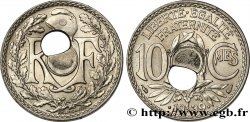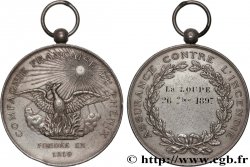fme_851287 - III REPUBLIC Médaille, Christophe - Joseph - Alexandre Mathieu de Dombasle, Comice agricole
75.00 €(Approx. 85.50$ | 63.75£)
Quantity
Add to your cart

Type : Médaille, Christophe - Joseph - Alexandre Mathieu de Dombasle, Comice agricole
Date: 1893
Metal : silver
Diameter : 36 mm
Orientation dies : 12 h.
Engraver Bescher
Weight : 46,32 g.
Edge : lisse + corne ARGENT
Puncheon : corne ARGENT
Coments on the condition:
Jolie patine grise hétérogène, présentant quelques rayures liées à un frottement au revers et dans les champs de l’avers. Petite usure
Obverse
Obverse legend : C. J. A. MATHIEU - DE DOMBASLE.
Obverse description : Tête nue à gauche de Mathieu de Dombasle en veste, signé : BESCHER.
Reverse
Reverse legend : COMICE AGRICOLE DU CANTON DE MAUZE. // CONCOURS / DU / 10 SEPTEMBRE / - / 1893.
Reverse description : Légende circulaire dans un médaillon entouré d’éléments agricoles dont une tête de cheval, une tête de boeuf et une tête de bélier, divers fruits et céréales.
Commentary
Christophe-Joseph-Alexandre Mathieu de Dombasle, couramment C.J.A. Mathieu de Dombasle ou simplement Mathieu de Dombasle, né à Nancy le 26 février 1777 et mort le 27 décembre 1843 dans la même ville, est un agronome français.
Fils d’un grand maître des Eaux & Forêts de Lorraine (titre héréditaire qui lui est enlevé sous la Révolution), aîné de huit enfants (dont trois meurent en bas âge), il fait ses premières études près de ses parents, puis entre à 12 ans au collège de Saint-Symphorien, tenu à Metz par les Bénédictins, mais la dispersion des ordres monastiques et la suspension des établissements d’instruction publique, sous la Terreur, viennent suspendre son élan dans les études. Alors il s’adonne aux beaux-arts, jusqu’à ce qu’il soit dirigé vers les camps militaires, combattant dans la campagne du Luxembourg, jusqu’à ce qu’il soit atteint, à 20 ans, d’une maladie nerveuse dont la petite vérole vient aggraver les effets.
Pour lire la suite de la biographie de notre personnage, allez à http://fr.wikipedia.org/wiki/Mathieu_de_Dombasle.
Fils d’un grand maître des Eaux & Forêts de Lorraine (titre héréditaire qui lui est enlevé sous la Révolution), aîné de huit enfants (dont trois meurent en bas âge), il fait ses premières études près de ses parents, puis entre à 12 ans au collège de Saint-Symphorien, tenu à Metz par les Bénédictins, mais la dispersion des ordres monastiques et la suspension des établissements d’instruction publique, sous la Terreur, viennent suspendre son élan dans les études. Alors il s’adonne aux beaux-arts, jusqu’à ce qu’il soit dirigé vers les camps militaires, combattant dans la campagne du Luxembourg, jusqu’à ce qu’il soit atteint, à 20 ans, d’une maladie nerveuse dont la petite vérole vient aggraver les effets.
Pour lire la suite de la biographie de notre personnage, allez à http://fr.wikipedia.org/wiki/Mathieu_de_Dombasle.








 Report a mistake
Report a mistake Print the page
Print the page Share my selection
Share my selection Ask a question
Ask a question Consign / sell
Consign / sell
 Full data
Full data









